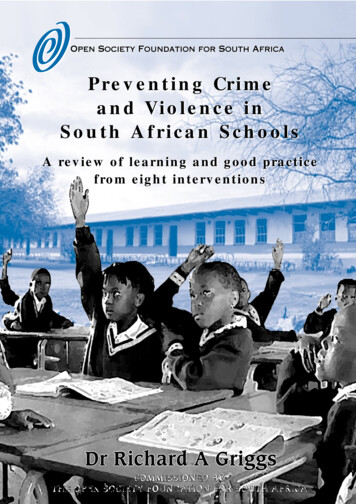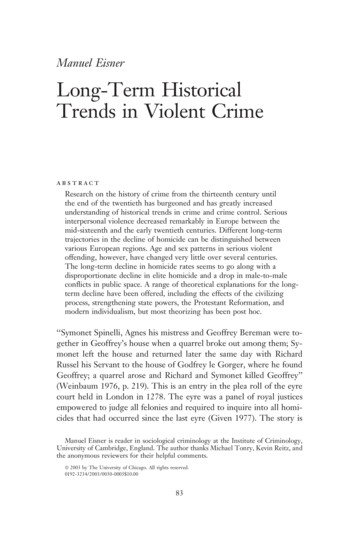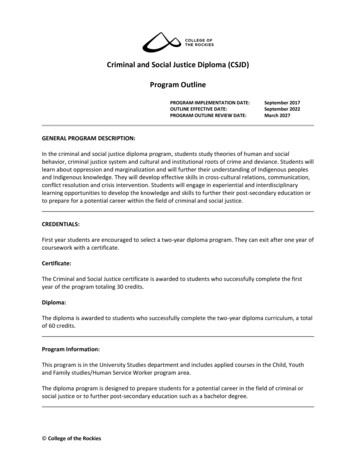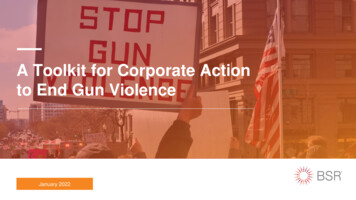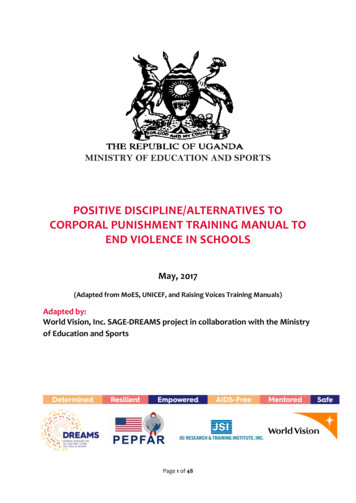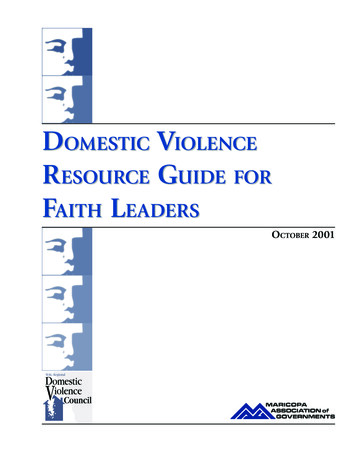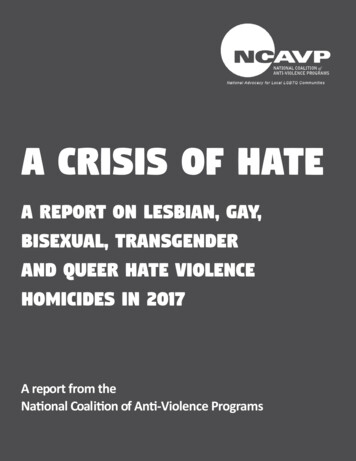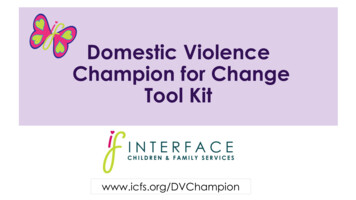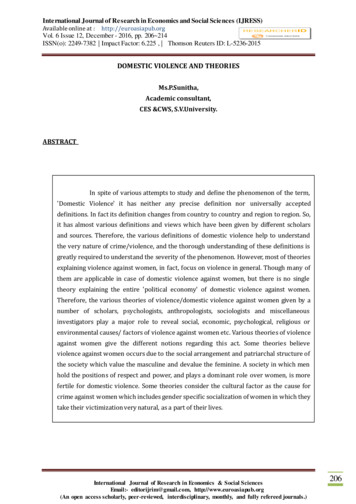
Transcription
E/INCB/2003/1I. Drugs, crime and violence: the microlevel impact1.Crime related to drug abuse is mostly non-violentand often petty. Economic-compulsive crime to obtaindrugs, such as theft and burglary, is more common thanviolent drug-induced assault. However, the impact ofillicit drugs, crime and violence is highly damaging tolocal communities at the microsocial level, as membersof those communities have to live in the midst of illicitdrug markets, where crime and violence, and the threatof crime and violence, are ever present.2.Crime and violence associated with drug abusetake on different forms at different levels in society.There are forms of crime and violence associated withinternational cartels, there is violent crime perpetratedby or against individual drug abusers and there areinnocent individuals who are caught in the crossfire ofviolent drug cultures. The International NarcoticsControl Board has chosen to review the impact ofdrugs, crime and violence at the microlevel in society,addressing the relationship between drug abuse, crimeand violence with respect to individuals, families,neighbourhoods and communities and taking intoaccount both criminality and victimization. The Boardintends to draw the attention of Governments to therelationship between drug abuse and trafficking at themicrolevel and the development of violence and crimeat the community level. The implementation byGovernments of the provisions of the internationaldrug control treaties dealing with drug abuse andtrafficking contributes to a reduction in violence andcrime, to the benefit of the prevailing social conditionsin a country.3.The macrolevel impact of drugs, crime andviolence, in relation to organized crime, drug trafficking and transnational criminal networks, is differentfrom, but closely related to, locally committed crime.The Board recognizes the importance of efforts to dealwith the problems of macrolevel drug trafficking andtransnational criminal networks, as well as criminaljustice efforts, at the national and international levels,to combat those problems; however, the focus of thepresent chapter is on the equally important localizedand targeted interventions with respect to groupsengaging in or at risk of violent drug-related crime andon the affected communities.A. Characteristics and possibleexplanations4.A relationship between drug abuse and othercriminal offences, including violent crime, can befound in various studies. Case studies of offenders whohave committed violent crimes such as homicide androbbery indicate that drug abuse is often a criticalfactor. In turn, some evidence suggests that higherrates of violence are associated with more frequentdrug abuse. At the same time, while some drug abusersengage in violent offending, other drug abusers areneither criminal nor violent. These findings have to becautiously interpreted for what they do not say aboutother causes of violent crime that are unrelated to illicitdrug abuse and for their selective interpretation ofevidence that does not provide insight about abuserswho are neither criminal nor violent. The violence thatis present in some families and some communities is,undoubtedly, not simply a product of localized illicitdrug abuse and trafficking. Violence linked to illicitdrug trafficking may also reflect a deep-seated cultureof violence in certain communities that has otherorigins, such as uneven distribution of income, civilunrest or war.5.Given these caveats, there is abundant evidenceabout the relationship between serious delinquency,crime, violent crime and drug abuse and the negativeconsequences for both individuals and communities;for example:(a) In the late 1990s, 69 per cent of arrestees infive police areas in the United Kingdom of GreatBritain and Northern Ireland tested positive for at leastone illicit drug upon being arrested; and 61 per cent ofthose arrested for assault tested positive for an illicitdrug; 1(b) In Brazil, drug-related violence is aparticularly serious national challenge that has anegative impact on communities. Of almost30,000 homicides registered annually, ahighproportion are linked to drug abuse and illicit drugtrafficking. Street children play an important part inthis illicit market, acting as couriers for drugtraffickers, and are frequently killed because they1
E/INCB/2003/1know too much, steal too much or are caught in thecrossfire between gangs and dealers;(c) In Latin America and the Caribbean, asurvey conducted by the World Bank on youth gangsand violence indicated that youth gangs involved indrug trafficking generally displayed higher levels ofviolence than those not involved in such activity. 26.The possible explanations of a relationshipbetween drug abuse and crime given in the presentchapter take into account the following key points:(a) Drug abuse might promote criminality, andcriminality might promote drug abuse;(b) Drug abuse and criminality might beinfluenced by any number of third variables: biological; psychological; situational; and environmental;(c) The way of policing illicit drug marketsmay have an impact on the criminality and violenceassociated with illicit drugs;(d) Socio-economic factors, particularly as theyimpact on young people, contribute to the extent andnature of crime related to drug abuse.7.The two core questions to consider are:(a) What the extent and nature of crime andviolent drug-related crime are at the microlevel insociety;(b) What the factors are that influence theslippage of individuals, families, neighbourhoods andcommunities into violent drug-related crime.B. Understanding drugs and crime8.The Board has examined the main areas thatshape the current way of thinking about drug abuse andantisocial behaviour, including violence, and has noteda number of factors that are offered, by differentresearchers in various disciplines, as causal explanations for a drugs/crime nexus. The main explanationsfor the relationship between substance abuse andaggression (or violence) can be characterized asfollows:(a) Explanations focusing on the individual,such as biological and physiological explanations,psychopharmacological explanations and psychological and psychiatric explanations. These disciplines2variously explore the impact of drug abuse onindividuals according to their physical and mentalcharacteristics and, to some extent, incorporate aspectsof social context to explain drug abuse and aggression.For example, psychopharmacological studies marry theindividual’s psyche with substance abuse to explorehow aggressive behaviour results from an interactionbetween drugs, personality and affective states ofbeing;(b) Explanations focusing on social andcultural factors. These disciplines include sociology,criminology, politics, economics, history, anthropologyand cultural studies. The disciplines variously explorethe relationship of social groups to drug abuse andcrime as context-specific and use examples from reallife. For example, socio-economic explanationsexamine income distribution, relative deprivation andsocial marginalization as they impact on differentsocial groups; such explanations consider theindividual and combined impact of each on drug abuseand related criminality.9.Disciplines based on the individual interpret drugabuse primarily as the outward symbol of internaldisorder. In comparison, disciplines offering explanations centred on sociological and culturally situatedstudies focus on social interaction, norms of conduct,sanctions and the setting of events as the mainexplanatory factors in the relationship between drugsand crime; these constitute the focus of the presentchapter. Explanations of drug abuse, crime andviolence are multifactorial; therefore, a range ofdisciplinary explanations can be utilized in an attemptto understand this relationship.Explanations based on the individual10. Studies that focus on the individual show thatdifferent illicit drugs have different impacts on themind and body and affect individuals to varyingdegrees. In turn, the effects of illicit drugs differaccording to the amounts consumed, the individual’sbody weight and history of drug abuse and theinfluence of genetic traits and personality predispositions on drug abuse. Controlled laboratorybased experiments on drug abuse and associatedviolence can only suggest a causal link betweenconsumption of “drug A” and “violence B”. In otherwords, it is very difficult, and misleading, to suggest adirect causal link between violence and illicit drug
E/INCB/2003/1ingestion without reference to culturally and sociallysituated factors that, in turn, influence an individual’sbehaviour.11. Focusing on one discipline in the vast literatureon drug abuse and aggression, psychopharmacologicalstudies have found that illicit and licit drugs, includingalcohol, can be associated with aggression but thatsome have no such association. There is a wealth ofevidence to support the assertion that alcohol consumption, under certain conditions, stimulatesviolence. In comparison, the ingestion of opiates, undercertain conditions, has been found to inhibitaggression, but withdrawal from long-term abuse ofthese and related substances has been found to result inirritability and hostility. Frequency of cocaine abuse,and amphetamine abuse, has been associated withincreased likelihood of involvement as a perpetrator inviolent crime. Also, the use of barbiturates appears tobe related to aggressive behaviour.12. While biologically and psychologically basedexplanations of the drugs/crime nexus provide a wealthof interesting insights, they do not account forsubcultural and cross-cultural variations in actualexperiences of drug abuse and its social consequences.The impact of illicit cocaine consumption andtrafficking on affluent social groups, as opposed topoorer communities, cannot be accounted for inlaboratory-controlled tests on drug abuse. In comparison, explanations focusing on social and culturalfactors are grounded in “real-life” examples ofcommunities that either experience or avoid problemsassociated with drug abuse, crime and violence.Explanations focusing on social and culturalfactors13. Evidence of socially and culturally situatedinfluences on crime and violence covers three broadareas: (a) subcultural and cross-cultural studies ofsocieties demonstrating conflicting evidence of aggression during substance abuse; (b) social-structuralpatterns of violence related to drug abuse according tovariables such as gender, age, race/ethnicity and socialclass; and (c) aggression that is illustrative ofsociocultural patterns, or conduct norms, that shapeviolent behaviour.14. The emergence and decline of crack cocainemarkets in the United States of America, together withthe associated rise and fall in the country’s violentcrime rate, from the mid-1980s to the early 1990s, areoften used to illustrate socially and culturally situatedinfluences on crime and violence. Violence associatedwith crack cocaine has often been explained by theviolent psychopharmological impact of the drug on theuser and by the rise of gun-toting gangs.15. It has been argued that drugs and violence arerelated in three separate and distinct ways (thetripartite model): (a) psychopharmacological, suggesting that violence is the result of the acute effect of apsychoactive drug on the abuser; (b) economiccompulsive, suggesting that violence is committedinstrumentally to generate money to purchase drugs;and (c) systemic, suggesting that violence is associatedwith the marketing of illicit drugs. Studies ence, including homicide, is most often associatedwith alcohol abuse. In comparison, economiccompulsive violence related to drugs is a rare event,but economic-compulsive crime to obtain drugs isfrequent. Systemic violence is closely related to “turf”battles over illicit drug markets.16. Studies that build on the above tripartite modelhave suggested that reduction in drug-related violenceis attributable to changing social norms or ways ofbehaving. In the case of New York, the city has beencharacterized as passing through distinct phases in itsstreet drug markets in relation to the predominant useof different types of illicit drugs. Each era is associatedwith distinct birth cohorts exhibiting characteristicbehavioural patterns associated with drug abuse.17. Historical evidence of birth cohort differences indrug abuse and resultant violent and non-violentbehaviour reveals the influence of different drugs andillicit drug markets and different social norms on crimeand violence. However, what data on this subjectcannot clarify is whether conduct norms are causalfactors in the decline in drug-related crime andviolence or whether non-violent and non-criminalconduct norms are simply a consequence of declininglevels of drug-related violence. In turn, conduct normsmust be interpreted as context-specific and as differingbetween social groups at any one time. Moreover, theimpact of drug-related crime and violence has to beinterpreted beyond the immediate impact that it has ondrug abusers and illicit drug trafficking, in order totake into consideration the insecurity experienced by3
E/INCB/2003/1members of communities whose daily lives are affectedby changing drug cultures.18. Consideration also needs to be given to otherrelevant factors shaping the relationship between drugsand crime over time, such as the general state of theeconomy and, in particular, levels of unemployment.The impact of prevailing socio-economic conditions ondrug-related crime, including violent crime, was thefocus of the report of the Board for 2002. 3 In short,communities that suffer from high unemployment andsocial insecurity are prime sites for infiltration by druggangs offering alternative sources of income. If thesituation is left unchecked, such communities maycollide with drug gangs and local traffickers, whoemploy violent tactics to secure their corner of theillicit drug market. However, not all communities withhigh unemployment and indicators of socialdeprivation will necessarily have high rates of crimeand drug abuse. Social safeguards and alternativeforms of income generation, resulting from efforts byGovernments and non-governmental organizations, intandem with the efforts of the local community, canstem the tide of crime and illicit drug markets.Conversely, high-income communities also have theirshare of drug abuse and crime; however, crime in thosecommunities tends to appear in the form of fraud ratherthan interpersonal violence.Impact of law enforcement on drugs, crime andviolence at the microlevel19. There is another factor that needs to beconsidered when attempting to understand thedevelopment of drug-related crime and violence at themicrolevel in society: the level and nature of interventions by local law enforcement agencies. The roleand activities of law enforcement agencies have consequences beyond the immediate setting of a particulardrug scene, as it affects the surrounding community. Inturn, police and criminal justice intervention needs tobe understood as a reflection of government policy andthe particular remit of political parties.20. Essentially, law enforcement interventions areintended to interdict criminal behaviour and punishcrime. The intention of efforts to remove perpetratorsfrom their environment through imprisonment is toprevent further crime and violence and to use the threatof punishment to discourage first-time offending orrepeat offending. Law enforcement interventions are4the most visible response to violence and drug abuse inmost countries. However, law enforcement has to beaccompanied by other measures in order to have thedesired lasting impact. Imprisonment alone maycontribute to increased violent behaviour instead ofreducing it.21. Crackdowns on illicit drug markets can haveunforeseen consequences for those drug abusers (andpersons not abusing drugs) who live in low-incomeneighbourhoods and for those who do not engage inoffending activities. Sensitive community policing,based on informed knowledge of local drug abusers,micro-traffickers and the concerns of “innocent”members of the local community, can ensure thatunsuccessful police crackdowns on local illicit drugmarkets are avoided. Targeted long-term police intervention, coupled with economic and social initiatives,can enhance the success of police efforts at themicrolevel. Communities that have suitable levels ofsocial support, offer alternative means of generatingincome and work in tandem with law enforcement arein a better position to avoid the pitfalls of policeintervention that fails to work in partnership with othercommunity agencies.22. Understanding the impact of law enforcement isimportant in designing intervention strategies. Localillicit drug markets, where buyers and sellers knoweach other, do not lend themselves to territorialcompetition. In comparison, illicit drug markets wherebuyers and sellers often do not know each other lendthemselves to increased territoriality and competition;hence, the potential for violence in public places suchas parks and bus stations. The impact of illicit drugmarkets in public areas, where violent competitionbetween sellers is rife, can only have negativeconsequences for local communities that have to usethose public areas where drug transactions occur. Asillicit drug markets mature, advancements in newtechnologies such as mobile (cellular) telephones,beepers and the Internet continue to be made andillegal drug transactions can increasingly be madeaway from public areas; as a consequence, the risk ofmembers of the community being caught intransactions between rival drug gangs that end inviolence may be reduced. However, the mostvulnerable drug abusers, those from the lower socioeconomic strata, such as many heroin addicts, areunlikely to have access to new technologies and willtherefore remain vulnerable to violent crime.
E/INCB/2003/123. When the policing of illicit drug markets is notaccompanied by efforts to provide alternative sourcesof income, it is highly likely that such police intervention will be unsuccessful in the long run becausethe members of the community will continue to bereliant on the illicit drug trade for their income. Theultimate worst-case scenario is the abandonment ofsuch communities by law enforcement authorities and,as a result, a violent power takeover by drug traffickinggangs.C. Youth, gangs, drugs and violence24. Successive longitudinal studies, accounting forvariations according to age, sex and ethnicity, haveindicated that, as young people move from adolescenceto adulthood, the proximal predictors of violencefluctuate. As parental influence reduces with age andpeer influence increases, the likelihood of youngpeople, essentially young men, being associated withcrime, violent crime and/or drug abuse will beenhanced when their situation is compounded bynegative factors. While it is difficult to identifyspecific factors as influencing youth involvement inviolent crime associated with drug offending, studieshave highlighted the following as contributing towardsyouth involvement in violent crime and/or drug abuse:(a) Environment: low socio-economic statusand/or unemployment in neighbourhoods with highcrime levels; high rates of victimization;(b) Familial variables: early separation fromparents; low attachment to parents; harsh parentalattitude; inconsistent parenting; witness to familialviolence;(c) Attitudes and associations: delinquent peerassociations; favourable attitude towards drug abuse orviolence;(d) Individual characteristics: minority groupmember; difficulties in school and/or school nonattendance;(e) Conduct problems and psychopathology:high rate of reported criminal activity; early onset ofdrug abuse; drug dealing; conduct disorder; antisocialpersonality; perceived or observed emotional problems.25. Given that much of drug-related crime andviolence centres on young males in marginalized socialpositions, the role of youth culture, in particular youthgangs, needs to be considered. A distinction should bedrawn between different types of youth gangs and theirrelationship to illicit drug markets and violence.Variations also exist in drug abuse and the violenceassociated with it among different gangs. Most gangviolence is endemic to youth gang culture, and drugabuse and drug trafficking associated with some gangsexacerbate a culture of violence normalization.Violence, such as intrafamilial violence, is also a partof gang members’ lives, either as perpetrators orvictims, outside the setting of the gang. Theintroduction of illicit drug consumption and competitive illicit drug markets can produce an explosivecocktail of violent crime that feeds on economic andcivil insecurity in vulnerable communities. Violentdrug cultures succeed in further destabilizing suchcommunities. In more affluent communities, wherevarious means exist to combat the negative impact ofillicit drugs, the introduction of such drugs is lesslikely to result in community destabilization.26. Another factor to consider is the availability anduse of weapons, in particular guns, to “secure” marketshares. There is evidence that illegal drug-selling has asignificant impact on illegal gun-carrying. Theincreased presence of guns enhances the culture ofviolence among gangs, which inevitably has an impacton members of the local community, who have to livewith the enhanced threat of violence.27. When considering the characteristics and causesbehind violent drug-related crime in youth, care mustbe taken not to lose sight of the following:(a) First, a relatively small group of serious andviolent juvenile offenders, who are also heavy drugabusers, account for a disproportionate amount of allserious crime committed by delinquents;(b) Second, while offending and violentoffending peak in adolescence and early adulthood, themajority of young people grow up and out of violentbehaviour once they reach their twenties.28. Likewise, while certain gangs retain membershipinto adulthood, the majority of adolescents leave thesocial enclave of gangs as they enter adulthood;however, the negative impact on communities of youthinvolvement in gang cultures, in particular, violentdrug gangs, has an impact that continues beyond thepoint when individual members leave, as new members5
E/INCB/2003/1are recruited and continue to inflict violence on theirlocal communities.D. Consequences and the way forwardImpact of drugs, crime and violence at themicrolevel29. Economic opportunities provided to criminalgroups by illicit drug markets enhance the scope forcrime and violence, as criminals compete for a share ofthose markets; that, in turn, may have dire consequences for the local community. Rivalries or “turfwars” between local drug dealers and traffickers candevelop into violent confrontations in and aroundpublic places and, as a result, make such places “no-goareas” for the general public.30. The deterioration of law and order inneighbourhoods where drug-related crime and violencehold sway means that the public’s willingness toidentify those involved, in an effort to stem the tide ofviolence, is held in check by a culture of fear and, inmany cases, distrust of the police. Added to that is thefact that communities may become dependent on localillicit drug markets that support whole economies and,therefore, are both unable and unwilling to challengethe status quo, as doing so might jeopardize personalincomes. The authorities themselves may also be in noposition to challenge violent drug-related crime incertain communities, as they too are at risk of violenceor they have been influenced by corruption and areconsequently in a state of inertia.31. The stress, anxiety and fear generated byexposure to crime and violence, in turn, interfere withthe daily lives and normal developmental progress ofpeople, in particular, young people: for example, theirability to trust and have a sense of personal safety;their ability to develop skills to control their emotions;their freedom to explore the local environment; andtheir ability to form “normal” social relationships.Exposure to violence, particularly starting at a youngage, is likely to result in the normalization of violentbehaviour and, in some cases, the actual manifestationof violence. Studies have shown that young males aged11-17 are at high risk of engaging in serious violence:(a) if they place importance on their families and spendtime with their families but are nevertheless exposed toattitudes favourable to violence; (b) if they engage in6drug abuse; (c) if they live in disorderedneighbourhoods; and (d) if they are frequentlyvictimized and simultaneously committing minor actsof delinquency.32. Since the early 1990s, the number of studies onintrafamilial violence and community-based violenceand on their impact on children and youth has grownexponentially. However, researchers are only nowbeginning to conceptualize the field with regard tomicrolevel violence in relation to: (a) the neighbourhood and the community; (b) the family and thehousehold; (c) relationships with parents and caregivers; (d) relationships with peers; and (e) personalcharacteristics. Understanding the interaction of thesedifferent areas and their influence on people’s lives canhelp in seeking explanations for people’s involvementin crime, violent crime and drug-related offending. Theinternational community would do well to turn itsattention to these areas in an effort to understand,combat and prevent the negative impact of illicit drugsand the related violent crime on both young people andadults in vulnerable communities.33. It goes without saying that crime is a hugeproblem, one that goes beyond its immediate impact onlevels of lawlessness. The social harm caused tocommunities, at the microlevel, by the involvement ofboth adults and young people in drug-related crime andviolence is immense. The very fabric of society ischallenged by the continued presence in communitiesof drug-related crime. Communities that suffer disproportionate levels of violent crime related to illicit drugsalso experience heightened levels of other criminalityand the disruptions to civil society associated with it.34. Social capital, or the degree of communityintegration, is an important consideration whenattempting to document and explain increases incommunity-level crime and violence. Social capitalrefers to the norms, or “laws”, that exist in socialrelations, and through social institutions, that instilfoundations for trust, obligation and reciprocity. Theextent of social capital in a community, or the degreeof social bonding according to established norms ofbehaviour, can help to explain levels of violence andcrime. Communities that lack social capital are likelyto suffer from more crime and violence. Absence orflight of social capital is exacerbated by increasedlevels of violence and crime that are related to thenegative impact of illicit drug markets on communities.
E/INCB/2003/1In Jamaica, a cyclical relationship between violenceand the destruction of social capital in five poor urbancommunities has been documented. 4 As a consequenceof violence, employment and educational opportunitieswere reduced, businesses did not invest in the localarea, local people were less likely to build new homesor make home improvements and freedom ofmovement was curtailed. In turn, those conditions,amounting to destruction of the local infrastructure andopportunities, increased the likelihood of violentbehaviour, particularly among young people, as mistrust was enhanced and civil norms were challenged.The relationship between loss of social capital andincreased violent crime, including violent drug-relatedcrime, cannot be ignored.35. In contrast to this example, Central Asia suffersfrom widespread drug trafficking, yet it has relativelylow levels of violent drug-related crime. That may bedue to strong family ties and the influence of strictsocial norms. However, evidence suggests that th
engaging in or at risk of violent drug-related crime and on the affected communities. A. Characteristics and possible explanations 4. A relationship between drug abuse and other criminal offences, including violent crime, can be found in various studies. Case studies of offenders who have committed violent crimes such as homicide and
